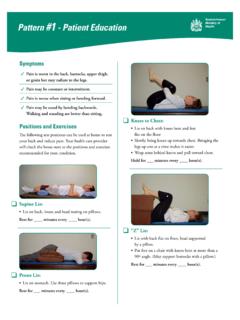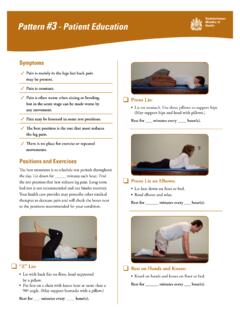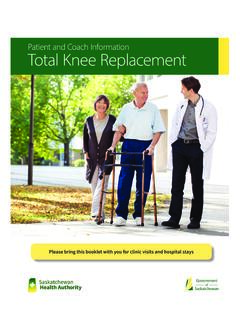Transcription of Canadian Stroke Best Practice Recommendations: …
1 Guidelines Canadian Stroke best Practice recommendations : Hyperacute Stroke Care Guidelines, Update 2015. Leanne K. Casaubon1,2, Jean-Martin Boulanger3,4, Dylan Blacquiere5, Scott Boucher6, Kyla Brown7, Tom Goddard8,9, Jacqueline Gordon10, Myles Horton11, Jeffrey Lalonde12, Christian LaRivi re13, Pascale Lavoie14, Paul Leslie15, Jeanne McNeill10, Bijoy K. Menon16, Brian Moses17, Melanie Penn18, Jeff Perry19,20, Elizabeth Snieder20, Dawn Tymianski1,2, Norine Foley21, Eric E. Smith16, Gord Gubitz7,8, Michael D. Hill16, Ev Glasser22, and Patrice Lindsay2,22* on behalf of the Heart and Stroke Foundation of Canada Canadian Stroke best practices Advisory Committee Correspondence: Patrice Lindsay*, Stroke , Heart and Stroke The 2015 update of the Canadian Stroke best Practice Recom- Foundation, c/o 11 Woodbank Road, Etobicoke, ON, Canada M9B 5C3.
2 Mendations Hyperacute Stroke Care guideline highlights key E-mail: elements involved in the initial assessment, stabilization, and 1. Neurosciences, University Health Network, Toronto, ON, Canada treatment of patients with transient ischemic attack (TIA), isch- 2. IHPME, University of Toronto, Toronto, ON, Canada emic Stroke , intracerebral hemorrhage, subarachnoid hemor- 3. Research Center, Charles-LeMoyne Hospital, Greenfield Park, QC, rhage, and acute venous sinus thrombosis. The most notable Canada change in this 5th edition is the addition of new recommen- 4. Neurology, Sherbrooke University, Montreal, QC, Canada dations for the use of endovascular therapy for patients with 5. Stroke , Saint John Regional Hospital, Saint John, NB, Canada acute ischemic Stroke and proximal intracranial arterial occlu- 6. Stroke Neurology, Regina Qu'Appelle Health Region, Regina, SK, Canada sion.
3 This includes an overview of the infrastructure and 7. Stroke , Halifax Infirmary, Halifax, NS, Canada resources required for Stroke centers that will provide endo- 8. Emergency Medicine, Dalhousie University, Annapolis, NS, Canada vascular therapy as well as regional structures needed to 9. Emergency Medicine, Annapolis Valley Health Region, Annapolis, NS, ensure that all patients with acute ischemic Stroke that are Canada eligible for endovascular therapy will be able to access this 10. Stroke , Horizon Health Network, Saint John, NB, Canada newly approved therapy; recommendations for hyperacute 11. Neurology, Fraser Health Region, Fraser, BC, Canada brain and enhanced vascular imaging using computed tomog- 12. Stroke , Kingston General Hospital, Kingston, ON, Canada raphy angiography and computed tomography perfusion;. 13. Emergency Medicine, University of Manitoba, Winnipeg, MB, Canada patient selection criteria based on the five trials of endovas- 14.
4 Neurosurgery, Laval University, Quebec City, QC, Canada cular therapy published in early 2015, and performance metric 15. British Columbia Emergency Health Services, Vancouver, BC, Canada targets for important time-points involved in endovascular 16. Calgary Stroke Program, Hotchkiss Brain Institute, Calgary, AB, Canada therapy, including computed tomography-to-groin puncture 17. Medicine, Southwest Health Region, Halifax, NS, Canada and computed tomography-to-reperfusion times. Other 18. Victoria General Hospital, Island Health Authority, Victoria, BC, Canada updates in this guideline include recommendations for 19. Ottawa Hospital Research Institute, Ottawa, ON, Canada improved time efficiencies for all aspects of hyperacute Stroke 20. Stroke , Ottawa Hospital, Ottawa, ON, Canada care with a movement toward a new median target door-to- 21.
5 WorkHorse Consulting, Windsor, ON, Canada needle time of 30 min, with the 90th percentile being 60 min. 22. Stroke , Heart and Stroke Foundation, Calgary, AB, Canada A stronger emphasis is placed on increasing public awareness of Stroke with the recent launch of the Heart and Stroke Foun- Received: 22 May 2015; Accepted: 19 May 2015 dation of Canada FAST signs of Stroke campaign; reinforcing Conflict of interest: Leanne K. Casaubon: Medtronic (as an independent the public need to seek immediate medical attention by calling study patient assessor for a cardiac TAVI study); NoNO Inc. as site PI for 911; further engagement of paramedics in the prehospital the Frontier study of NA-1 neuroprotective in Stroke ; Covidien as an phase with prehospital notification to the receiving emer- advisory board member. Jean-Martin Boulanger: conference speaker for gency department, as well as the Stroke team, including neu- BI Novartis, Sanofi Aventis, Merck, Merz, Allergan, Pfizer, Bayer, Boeh- roradiology; updates to the triage and same-day assessment ringer Ingelheim.
6 Gord Gubitz: speaker for Bayer, Boehringer Ingleheim, and BMS Pfizer. Dr. Michael D. Hill: Heart and Stroke Foundation of Alberta Board Chair, salary award holder; Vernalis Group Ltd and Merck Ltd Consultant; Hoffmann-LaRoche Canada, provided drug for clinical Melanie Penn, Jeff Perry, Elizabeth Snieder, Dawn Tymianski, Norine trial, consultancy and CME lecturer; Coviden, research grant holder; Foley, Eric E. Smith, and Ev Glasser. Servier Canada, CME lecturer (funds donated to charity); BMS Canada, Funding: The development of the Canadian Stroke best Practice Recom- consultancy (funds donated to charity); Alberta Innovates Health Solu- mendations is funded in their entirety by the Heart and Stroke Founda- tions, program grant award; principal investigator, ESCAPE trial. Brian tion, Canada. No funds for the development of these guidelines come Moses: speaker for AstraZeneca, Bayer, Boehringer Ingelheim, Sanofi from commercial interests, including pharmaceutical and medical device Aventis, and Servier; speaker and advisory board member for BMS, Eli companies.
7 All members of the recommendation writing groups and Lilly, Merck, NovoNordisk, Pfizer; advisory board member for Medtronic. external reviewers are volunteers and do not receive any remuneration for The following co-authors do not have any conflicts of interest to report: participation in guideline development, updates, and reviews. All partici- Patrice Lindsay, Dylan Blacquiere, Scott Boucher, Kyla Brown, Tom pants complete a conflict of interest declaration prior to participation. Goddard, Jacqueline Gordon, Myles Horton, Jeffrey Lalonde, Christian LaRivi re, Pascale Lavoie, Paul Leslie, Jeanne McNeill, Bijoy K. Menon, DOI: 924 Vol 10, August 2015, 924 940 2015 World Stroke Organization L. K. Casaubon et al. Guidelines of patients with transient ischemic attack; updates to blood angiography (CTA) and computed tomography perfusion (CTP).
8 Pressure recommendations for the hyperacute phase of care as well as patient selection for endovascular therapy. for ischemic Stroke , intracerebral hemorrhage, and subarach- The present publication summarizes the recommendations for noid hemorrhage. The goal of these recommendations and supporting materials is to improve efficiencies and minimize the hyperacute period. Other up-to-date and comprehensive the absolute time lapse between Stroke symptom onset and CSBPR for all stages of Stroke care and recovery are freely available reperfusion therapy, which in turn leads to better outcomes at (2) and in a recent publication of and potentially shorter recovery times. the Prevention of Stroke recommendations in this journal (4). Key words: endovascular therapy, guidelines, hyperacute Stroke care, recommendations , detailed rationales, supporting evidence, neurovascular imaging, thrombolysis system implications, performance measures, as well as patient and professional education resources are detailed on our website.
9 Introduction What's new in 2015. Stroke is a burden across the globe; in Canadian hospitals, one patient is treated every nine-minutes for a Stroke or a transient In the 2015 update of the Hyperacute Stroke Care module, there ischemic attack (TIA) (1). Stroke is also the third cause of death in are several notable updates. The theme of this update is Working Canada and a leading cause of disability (2). Together, and so there is a strong focus on the interprofessional The Canadian Stroke best Practice recommendations (CSBPR) teams of healthcare workers involved in the hyperacute care of are evidence-based guidelines that are updated and released every people with Stroke , including paramedics, emergency department two-years (or more frequently as necessary) (2). They address the (ED) teams, Stroke teams, and radiology (including neurointer- continuum of Stroke care from Stroke symptom onset through the ventionalists), emphasizing each healthcare professional's respon- hyperacute period to rehabilitation and longer-term recovery.
10 Sibilities in the hyperacute care period. The target audience for the CSBPRs includes all healthcare pro- There are two time phases that are noted in the recommenda- fessionals involved in the care of patients with Stroke or TIA tions: phase 1 includes prehospital care by paramedics and other across that continuum. The present publication addresses the Emergency Medical Services (EMS) personnel; phase 2 includes hyperacute period for Stroke and is intended for all members of ED care. There is an updated recommendation for prehospital the interdisciplinary healthcare team who care for Stroke patients notification of the ED care team by paramedics/EMS personnel and their families throughout this stage of care. that includes detailed patient-specific information that must be Hyperacute Stroke care specifically refers to the key interven- relayed in this prehospital time phase (section 2).









